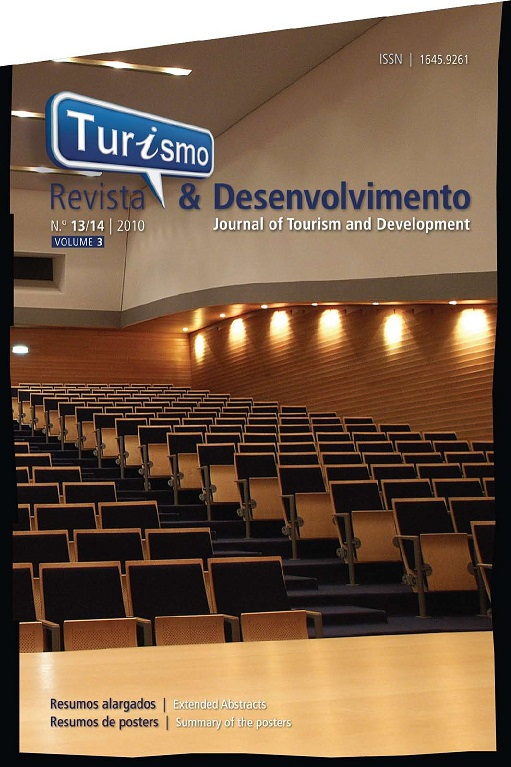Analysing destination image structure: the case of rural north Portugal
Resumo
Objectives | This paper studies the concept, assessment, structure of destination image as well as its behavioral relevance in the context of marketing a rural tourist destination. Based on a literature review, a series of hypotheses are advanced, which are tested empirically, analyzing the image of North Portugal as a rural tourist destination. The focus of this paper is the assessment of the region’s destination image and the analysis of its structure, with affective, cognitive, imagery and holistic components considered as main elements. Relationships between image components are presented in a path-analytical model ranging from cognitive image over functional congruity and affective image to holistic destination image. Destination-self-congruity is considered an affective component of destination image, eventually moderated by psychographic traveler type. The relations between image components and intentional future travel behavior are also analyzed. Implications of results on destination marketing are suggested, as well as recommendations for future destination image research.
Methodology | The present research project, financed by the Regional Coordinating Commission of North Portugal (CCRN), is based on a study of the rural tourism market of North Portugal.A survey with tourists staying in rural areas in the region was undertaken from summer 1998 to summer 1999, yielding 2280 valid responses. For data collection locations were selected as those most likely to attract tourists from pre-defined rural counties. These sites were visited regularly during one year and all tourists present were interviewed, using a “cluster sampling approach” (defined by place and time). This approach was complemented by another at the Oporto airport and an indirect approach via accommodation units, but, 88% of responses were obtained by direct administration. Destination image was assessed both qualitatively and quantitatively, based on results from literature review and an exploratory phase. The moderating variable ‘psycho-graphic traveler type’ was operationalized based on indicators of travel behavior suggested by Plog (1974).
Main results and contributions | Results confirmed the existence of a very complex destination image, containing diverse cognitive, affective, imagery and holistic elements. The category nature stood out as the most central and complex dimension, with culture, gastronomy and friendly people also relevant. The object valence was predominantly positive. A simultaneously pleasant and peaceful atmosphere reveals the position of the destination on the affective dimensions pleasantness and arousal suggested in environmental psychology (Russel & Lanius, 1984). Thus, a more holistic and psychologically shaped destination image containing the elements nature, peacefulness and pleasantness was most associated with North Portugal. Affective image is also determined by friendliness of population. Since affective image was suggested as most related to motivation, these aspects should receive particular attention in the region’s destination marketing.As more unique elements, relevant for positioning the region competitively, aspects related to specific landscape elements, culture, wine and gastronomy stand out. The test of relationships between cognitive, affective and overall image confirmed the suggested path from cognition over affect to a holistic image. This path has also been found in other consumer behavior studies within tourism, being an important contribution to information integration theory concerning destination image formation,confirming the hierarchy of effects paradigm (Sirgy, 1983). In this context, the variable functional congruity, similar to Sirgy & Su´s (2000) construct of a destination’s subjectively defined instrumentalvalue, played a significant mediating role. It may be used as a surrogate for the overall cognitive image, reflecting the evaluation of most valued aspects of a rural tourism experience. Functional congruity was identified as particularly relevant for overall affective and overall image. Destination-self-congruity, best measured as a single overall dimension (Kastenholz, 2004a), revealed a strong relationship with the overall affective image dimension pleasantness, which was the stronger the more psycho-centric the tourist, as expected. Generally, the outstanding role of destination image on behavioral intentions could be confirmed, with stronger effects observable for the probability to recommend than for the probability to return.
Limitations | The here identified contents may be more relevant for rural tourist destinations, and even specific to rural North Portugal. It would be interesting to increase the geographical scope of the image object; particularly considering how the market defines “North Portugal”, which might not correspond to the administrative region. In any case, further research in other destination contexts (e.g. urban or beach), may help identify more generalizable patterns of destination image structure. Destination image assessment may be undertaken with different, eventually complementary techniques and measures used may be improved. The here presented results only show part of the picture, since distinct conditioning factors, also analysed in the thesis, might lead to distinct destination image determinants, structures and consequences.
Conclusions | Results about the constitution of a rural tourism destination’s image, as perceived by its visitors, should be relevant for destination marketing in general, suggesting the relevance of addressing the diverse destination image components for creating an appealing and distinctive overall image, composed of a variety of interrelated elements, with both cognitive and affective loadings. The analyses confirmed the relevance of destination image for intentional future travel behavior, justifying continuous efforts in its research, both from a theoretical and practical, destination marketing point of view. Image analysis helps identifying relevant weak points to be improved as well as strong points to be enhanced. That is, destination image studies assist in product (destination) development and market communication. The development of a strong destination brand image must be based on both product (destination)-reality, valued by the market, and effective market communication. If an image is understood as a meaning profile (Durgee & Stuart, 1987), associations of meanings, symbols and features must be carefully controlled, also shared by local residents, and effectively directed to a selected target-market, which in the end enhances sustainable destination development (Kastenholz, 2004b)





